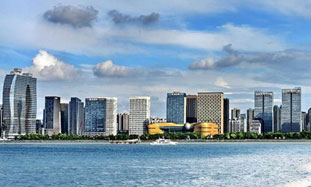Huzhou Economic & Technological Development Zone
Survey of Huzhou Municipality
Administrated by the Zhejiang government, Huzhou governs Wuxin Section, Nanxun Section, Deqing County, Changxing County and Anji County. The city covers an area of 5,800 kilometers with 2.62 million population, of which 350,000 are urban residents.
As one of the 15 "First Planning and First Developing" cities approved by the State Council to connect Pudong Development Zone, Huzhou enjoys the advantages of convenient geographical location and solid economic foundation.
To the Southwest of Huzhou lies the Tianmu Mountains, which nestles in the source of Huangpu River. The Northeast of the city lies on the Taihu Plain. The annual average temperature is 15 C. The average temperature in the coldest month is 3.1 C and that for the hottest month during the year is 27.9 C. The annual precipitation is 1238.8 mm. The annual average wind speed is 3.2 meters per second, mainly from the southeast.
Huzhou was called Wuxin in the old days, and is one of the origins of the Chinese national industry. The main industries include machinery, electronic appliance, textile, light industry, chemical and construction material.
Location
Huzhou is situated north of Zhejiang province, south bank of Taihu Lake, which is the third largest fresh water lake in China. The city is 150 kilometers (shorten to 120 kilometers after acceptance for highway) from Shanghai to the east, 86 kilometers from Hangzhou to the south, 110 kilometers from Wuxi and 90 kilometers from Suzhou to the north, and 220 kilometers from Nanjing to the northwest. It lies in the center of the Yangtze River Delta and Shanghai Economic Circle.
Communication
Surrounded by Shanghai and Jiangsu, Zhejiang and Anhui provinces, Huzhou is an important communication pivot both on the river and on the land.
By Land
Both No 318 National Road (Shanghai-Lasa) and No 104 National Road (Beijing-Fuzhou) pass across Huzhou Economic & Technological Development Zone (HETDZ) from east to west, and from north to south, respectively. It is 150 kilometers from Huzhou to Shanghai, 220 kilometers to Nanjing, and 86 kilometers to Hangzhou.
The highway from Shanghai to Huzhou, a section of the Shen-Zhe-Wan highway (Shanghai-Huzhou-Hefei), is under construction. After the highway acceptance (in early 2005 expected), the distance between Huzhou and Shanghai will be shorten to 120 kilometers with a designed speed at 120 kilometers per hour. The total length of Ning-Hu-Hang highway (Nanjing-Huzhou-Hangzhou) is 220 kilometers, while the 68-kilometer Huzhou-Hangzhou section has already been finished. This highway will be accepted by the end of 2003.
By Rail
The railway in Huzhou is the pivot of the national rail system: the railways leading to the main cities all over the country joins here. There are stations inside HETDZ for cargo and passenger transfer.
By River
The Hu-Shen River (Huzhou-Shanghai) is one of the most important rivers in the Yangtze River Delta. It is classified as a 4th class river with a 500 ton navigable capacity for a single vessel. The annual transport capacity reaches 80,000,000 tons.
Survey of HETDZ
Approved by the Zhejiang government, HETDZ was established in 1992, and was among the nine major provincial level development zones approved by the State Council in 1997. In 2000 the Zhejiang government approved the plan of building Zhejiang Hi-tech Industry Area inside HETDZ.
Overall Plan
HETDZ is situated northwest of the city, adjacent to the city downtown, with a planned area of 70 kilometers. It can be divided into six sections, namely Fenghuang Industry and Trade Section, Xisai Port Warehousing Section, Yangjiabu Heavy Industry Section, Renhuangshan New Section, South Taihu Tourism & Holiday Center, Southwest Industry Section.
Infrastructure
HETDZ is fully equipped with completed infrastructure, such as telecommunication bureau, postal center, transit station combined by rail, road and river transportation with an annual handling capacity of 1,100,000 tons, thermal power station supplying 600,000 ton steam annually, gas pipe system, transforming substation, water mill with a 100,000 ton capacity, and sewage treatment plant. HETDZ Fenghuang Industry and Trade Section is also well equipped with electronic power, telecommunication (broadband), sewage treatment, heat water and steam supply.
Administration Efficiency & Law Environment
HETDZ is a provincial level development zone approved by the Zhejiang government, and is among the nine major provincial development zones in China approved by the State Council to have provincial development authority. The zone has established a complete serving and supporting system for investment. The Administrative Committee of HETDZ provides a series of outstanding services, ranging from company registration, construction to production.
Huzhou is one of the origins of the modern national industry, and is also one of the earliest open cities following the opening-up policy.
Labor Force
The city's education is on the top level in mainland China. Over 83 percent staff has received high school education or mid-professional education. Besides, located close to Shanghai, Hangzhou and Nanjing, where locates enormous outstanding universities such as Zhejiang University, Tongji University, Fudan University, Shanghai Community University and Nanjing University, Huzhou is strongly supported by professional experts, who brings sophisticated technology to Huzhou.
Living Environment
Huzhou faces Taihu on the north, and leans against Tianmu Mountains on the south. Surrounded by green mountains and fresh water, Huzhou is an ideal place to live. Among all the cities included in the Taihu Area, Huzhou is the only city that is named after Taihu. It is well-known as a "Silk City, Fish & Rice Land and Culture Center" in history. In 2000 Huzhou was entitled "World's Most Livable City" by the United Nations. At present Huzhou aims to develop to be a modern garden city, most suitable for living around the Yangtze River Delta.
Development Potentialities
The High-lighted Development Zone in China
With Shanghai as its center, the Yangtze Delta is the most prosperous development zone in China, covering 99,000 kilometers with 100 million population, occupying 22 percent of the country's GDP and 25 percent of the country's revenue, with an annual average economic growth rate reaching 12 percent during the recent 15 years.
Huzhou, the center of Yangtze Delta
It is a great opportunity to penetrate the market in Yangtze Delta to invest in HETDZ, as Huzhou is within 200 kilometers from Shanghai, Nanjing, Hangzhou, Suzhou and Wuxi by road.

 Print
Print Mail
Mail
 20 Cultural Symbols
20 Cultural Symbols Why Zhejiang
Why Zhejiang Experiencing high-tech products at WIC
Experiencing high-tech products at WIC Zhejiang Release
Zhejiang Release Zhejiang News
Zhejiang News